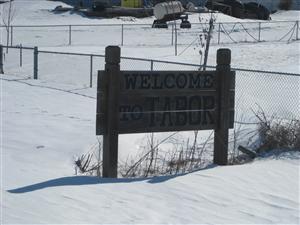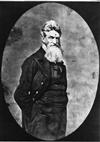 We have made this an optional tour stop because it will add about 150 miles to the length of the tour.
We have made this an optional tour stop because it will add about 150 miles to the length of the tour.
Directions: The Todd House [ Waypoint = N40 53.936 W95 40.582 ] is located on Park Street, in Tabor, Iowa 51653.

Like the Reverend Samuel L. Adair of Osawatomie, Kansas, Congregational Minister John Todd was a graduate of the Oberlin Theological Seminary in Ohio. Todd was among the founders of Tabor, Iowa and built the house at which you are looking in 1853. Todd organized the Tabor Congregational Church with eight members on October 12, 1852.
John Todd was an ardent abolitionist. He later described the effect of his training – “Of all the thousands of Oberlin students, I never knew one who studied there long, who did not go out from there a thorough abolitionist.”
Tabor, Iowa was an important staging area for free-state emigrants entering into Kansas by way of the Lane Trail. Tabor would also be used as a source of arms and safe zone for free-state supporters engaged in Bleeding Kansas. Todd later described, in his Reminiscences book, Tabor's role in the free-state emigration:
“Companies of emigrants from Illinois, traveling in their own wagons through northern Missouri, were turned back from guarded ferries on the Missouri, and compelled to retrace their course. The blockade of the river rendered it necessary to seek some other way of ingress into the territory. Accordingly in the forepart of the summer of 1856, in May or June, a small company, led by Dr. Howe, of the blind institution in Boston, coming from Kansas across the country via Nebraska City, made their appearance in Tabor. This, I think, was the beginning of the travel of free state men through Tabor. … From this time onward through that season, Tabor, being the nearest point to Kansas, where all the people were in full sympathy with the free state movement, was made a place of deposit for military and commissary stores. Our latchstrings were always out, and much of the time our houses, and granaries, and hay mows were occupied. Provisions were plenty and free, and without price. Persons were passing through almost daily, alone or in companies.”
John Brown found Tabor, Iowa the ideal spot at which to train his men to fight pro-slavery forces in the Kansas Territory. He would also bring his wounded and sick back to Tabor where they could heal in safety.
In the fall of 1856 according to Todd, he “had one brass cannon on his hay mow, and another in his wagon shed,” as well as “ boxes of muskets, boxes of sabres, and twenty boxes of Sharps rifles stowed away in the cellar all winter.”
Tabor also became an important stop on the Underground Railroad for fugitive slaves fleeing the south. Most of the fugitive slaves coming through Tabor had escaped from Missouri and Arkansas. The Todd House was a well know station along the Underground Railroad. Todd described the first fugitives to be helped to freedom in Tabor:
“On the evening of the 4th of July, 1854, there came into our quiet village a traveler with his family and several colored people, three covered wagons and a carriage. They were on their way from Mississippi to Salt Lake...There were six slaves [who were] anxious to escape from slavery... Arrangements were then made, [and they] were met at the corner by the hotel in the night and conducted to and across the Nishnabotna and concealed in the bushes. ... On their way out they had some narrow escapes, but were delivered from all their foes.”
 In February of 1859, John Brown stayed at the Todd House on his way to Canada with the eleven slaves he had liberated from Missouri in December 1858. Because of the violence that took place on John Brown's raid into Missouri (one of the slave owners was killed), he received a very cool reception in Tabor. In his Reminiscences, Todd describes this:
In February of 1859, John Brown stayed at the Todd House on his way to Canada with the eleven slaves he had liberated from Missouri in December 1858. Because of the violence that took place on John Brown's raid into Missouri (one of the slave owners was killed), he received a very cool reception in Tabor. In his Reminiscences, Todd describes this:
“Before the Sabbath was past it was reported in Tabor that Missouri had been invaded and life had been taken to procure these slaves... the citizens proceeded to adopt some resolutions expressive of their views of the captain's invasion of Missouri. They could not approve of an armed invasion of a neighboring state with which we were ostensibly at peace. ...With mingled surprise and indignation Captain Brown repaired to the residence of Brother Geo. B. Gaston, whose hospitality he had been enjoying, apparently feeling that if friends deserted him he must "trust in God and keep his powder dry." In feeble health from continued exposure, beset with a persistent ague, he seemed to feel forsaken; he carefully examined and grasped more firmly his weapons and curtailed his stay in Tabor.”
The Todd House also was used by John Brown as a warehouse for some of the arms he was stockpiling before his raid on Harper's Ferry. The arms were stored in the basement even though John Todd did not know for what the arms were going to be used.